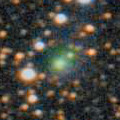
|
Now it is bright as 10.5 mag (May 3, Seiichi Yoshida). It is expected to brighten up to 9 mag in summer. In the Southern Hemisphere, it stays observable in good condition for a long time until the comet will fade out. In the Northern Hemisphere, it is observable only until June.
Date(TT) R.A. (2000) Decl. Delta r Elong. m1 Best Time(A, h)
May 5 19 41.17 -10 43.1 1.961 2.475 108 10.4 3:31 (333, 41)
May 12 19 38.24 -13 25.8 1.815 2.440 116 10.2 3:22 (341, 40)
|

|
Now it is 11.2 mag (May 4, Juan Jose Gonzalez). It stays bright as 11 mag for a long time. In the Southern Hemisphere, it is not observable for a long time after this. In the Northern Hemispehre, it stays observable for a long time until the comet fades out. But it will be getting lower gradually after this.
Date(TT) R.A. (2000) Decl. Delta r Elong. m1 Best Time(A, h)
May 5 5 22.81 44 11.1 3.245 2.603 43 11.0 20:23 (128, 25)
May 12 5 36.75 45 26.1 3.289 2.602 40 11.1 20:31 (131, 22)
|
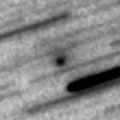
|
It brightened rapidly as expected. Now it is very bright as 10.8 mag (Apr. 20, Katsumi Yoshimoto). It stays at 11-12 mag until June. In the Southern Hemisphere, it stays observable in excellent condition. In the Northern Hemisphere, it will be unobservable from April to June when the comet becomes brightest.
Date(TT) R.A. (2000) Decl. Delta r Elong. m1 Best Time(A, h)
May 5 22 3.17 -38 20.5 0.905 1.304 85 11.9 3:31 (320, 1)
May 12 22 36.86 -36 44.9 0.898 1.294 85 11.8 3:22 (316, 0)
|
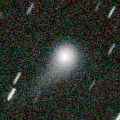
|
Now it is 11.9 mag (May 4, Juan Jose Gonzalez). It stays 12 mag for a long time until spring in 2019. In the Northern Hemisphere, it stays observable in good condition for a long time, although it becomes unobservable temporarily from mid June to August. In the Southern Hemisphere, it is not observable until September.
Date(TT) R.A. (2000) Decl. Delta r Elong. m1 Best Time(A, h)
May 5 7 47.88 57 11.4 2.986 2.780 68 12.1 20:23 (139, 49)
May 12 7 48.77 54 4.3 3.068 2.761 63 12.1 20:31 (134, 45)
|

|
The condition of this apparition is worst. It brightens up to 12.5 mag from April to May. But it is not observable at all.
Date(TT) R.A. (2000) Decl. Delta r Elong. m1 Best Time(A, h)
May 5 2 57.53 13 19.2 1.615 0.613 3 12.6 20:23 (122,-18)
May 12 3 43.21 15 24.4 1.637 0.649 7 13.1 20:31 (122,-15)
|
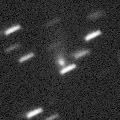
|
Now it is 14.4 mag (Apr. 8, Alexander Baransky). It will brighten up to 9 mag in summer. However, it is hardly observable when it is bright. In the Northern Hemisphere, it is not observable until late December. In the Southern Hemisphere, it is observable from July to September, but it locates in extremely low.
Date(TT) R.A. (2000) Decl. Delta r Elong. m1 Best Time(A, h)
May 5 2 44.08 28 25.2 2.526 1.556 12 12.9 3:31 (226, -8)
May 12 2 59.69 26 44.8 2.450 1.463 9 12.6 3:22 (228, -9)
|
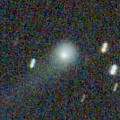
|
Now it is very bright as 12.2 mag (May 4, Juan Jose Gonzalez). It will be observable at 12-13 mag for a long time from 2017 to 2018. In the Southern Hemisphere, it will be hardly observable after this.
Date(TT) R.A. (2000) Decl. Delta r Elong. m1 Best Time(A, h)
May 5 13 43.87 56 58.5 3.389 3.789 105 13.0 22:49 (180, 68)
May 12 13 20.99 56 42.5 3.466 3.800 101 13.1 21:59 (180, 68)
|

|
Appearing in the morning sky. Now it is faint as 16.5 mag (May 5, Jean-Francois Soulier).
Date(TT) R.A. (2000) Decl. Delta r Elong. m1 Best Time(A, h)
May 5 23 3.24 -2 2.1 6.253 5.784 58 13.7 3:31 (283, 15)
May 12 23 6.77 -1 31.6 6.157 5.784 63 13.7 3:22 (285, 18)
|
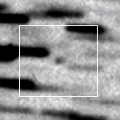
|
Now it is 14.8 mag (Apr. 26, Catalina Sky Survey). It will brighten rapidly after this, and it will brighten up to 11 mag from summer to autumn. It is observable in excellent condition in the Southern Hemisphere. It locates somewhat low in the Northern Hemisphere.
Date(TT) R.A. (2000) Decl. Delta r Elong. m1 Best Time(A, h)
May 5 21 10.99 -15 35.3 1.921 2.150 88 14.0 3:31 (314, 25)
May 12 21 22.75 -15 19.5 1.829 2.131 92 13.7 3:22 (315, 27)
|
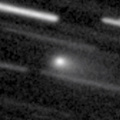
|
Now it is bright as 12.6 mag (Apr. 16, Chris Wyatt). It will be observable at 13-14 mag in good condition from spring to summer.
Date(TT) R.A. (2000) Decl. Delta r Elong. m1 Best Time(A, h)
May 5 21 50.88 -18 17.4 1.432 1.610 80 13.9 3:31 (308, 17)
May 12 22 7.43 -16 17.8 1.387 1.612 82 13.9 3:22 (307, 19)
|
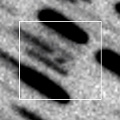
|
Now it is 16.4 mag (Apr. 22, Toshihiko Ikemura, Hirohisa Sato). It will brighten rapidly, and brighten up to 7 mag from August to September. In the Northern Hemisphere, it will be observable in excellent condition. In the Southern Hemisphere, it will be unobservable from July to August. But it will be observable in good condition before and after tha.
Date(TT) R.A. (2000) Decl. Delta r Elong. m1 Best Time(A, h)
May 5 19 47.55 20 14.0 1.517 1.932 97 14.9 3:31 (302, 66)
May 12 19 58.14 23 20.0 1.416 1.868 99 14.5 3:22 (299, 69)
|

|
It brightened up to 7.1 mag from May to June in 2017 (June 21, Juan Jose Gonzalez). Now it is fading. It has already faded down to 15.7 mag (Apr. 14, B. Lutkenhoner, G. Gasparovic, Y. Chen). In the Southern Hemisphere, it stays observable for a long time after this. It will never be observable again in the Northern Hemisphere.
Date(TT) R.A. (2000) Decl. Delta r Elong. m1 Best Time(A, h)
May 5 1 3.45 -43 0.9 4.540 4.192 63 14.9 3:31 (304,-30)
May 12 1 12.22 -42 57.9 4.547 4.257 67 15.0 3:22 (304,-28)
|
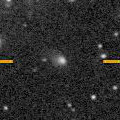
|
Now it is 15.0 mag (Apr. 19, Toshihiko Ikemura, Hirohisa Sato). It is expected to brighten up to 13-14 mag from 2018 to 2019. In the Northern Hemisphere, it stays observable in good condition for a long time. In the Southern Hemisphere, it locates extremely low until summer.
Date(TT) R.A. (2000) Decl. Delta r Elong. m1 Best Time(A, h)
May 5 19 19.71 45 10.6 3.868 4.051 93 15.0 3:31 (223, 75)
May 12 19 11.34 45 47.9 3.768 4.013 96 14.9 3:22 (207, 78)
|

|
Now it is 15.5 mag (Apr. 25, J. Drummond). It stays 15 mag from 2018 to 2019, and it will be observable for a long time in the Southern Hemisphere. In the Northern Hemisphere, it will never be observable again.
Date(TT) R.A. (2000) Decl. Delta r Elong. m1 Best Time(A, h)
May 5 12 44.87 -68 5.4 3.922 4.569 124 15.3 21:51 ( 0,-13)
May 12 12 32.98 -68 1.9 3.898 4.539 123 15.2 21:12 ( 0,-13)
|
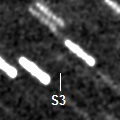
|
It is expected to approach to Sun down to 0.2 a.u. and brighten up to 3 mag in August. Now it is 16.6 mag (Apr. 22, Thomas Lehmann). In the Northern Hemisphere, it stays observable in the morning sky until early August when the comet brightens up to 6 mag. It is not observable at all in the Southern Hemisphere.
Date(TT) R.A. (2000) Decl. Delta r Elong. m1 Best Time(A, h)
May 5 0 1.36 54 43.4 2.737 2.228 50 15.7 3:31 (222, 31)
May 12 0 17.62 55 23.7 2.619 2.118 50 15.3 3:22 (221, 31)
|

|
Appearing in the morning sky. It is observable at 15 mag in 2018, in good condition in the Southern Hemisphere. It locates somewhat low in the Northern Hemisphere.
Date(TT) R.A. (2000) Decl. Delta r Elong. m1 Best Time(A, h)
May 5 22 44.41 -16 57.9 3.300 3.074 68 15.8 3:31 (298, 9)
May 12 22 52.24 -16 29.4 3.223 3.085 73 15.7 3:22 (299, 11)
|
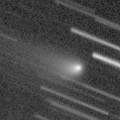
|
Appearing in the morning sky. It is fading now. But it stays 16 mag until summer. But actually, it is 18.1 mag (Mar. 23, Toshihiko Ikemura, Hirohisa Sato), fainter than this ephemeris.
Date(TT) R.A. (2000) Decl. Delta r Elong. m1 Best Time(A, h)
May 5 18 30.35 -26 28.5 3.012 3.711 127 15.9 3:31 (357, 29)
May 12 18 16.71 -27 3.8 2.953 3.757 137 15.9 3:00 ( 0, 28)
|

|
It brightens up to 16 mag in spring. In the Southern Hemisphere, it stays observable until August, but it will be unobservable after that. In the Northern Hemisphere, it stays unobservable until June, but it will be observable in good condition after that. Its cometary activity was observed on Mar. 26 (M. Mommert, D. Polishook, N. Moskovitz).
Date(TT) R.A. (2000) Decl. Delta r Elong. m1 Best Time(A, h)
May 5 0 0.14 -19 13.0 1.524 1.240 54 16.0 3:31 (289, -7)
May 12 0 18.63 -14 58.0 1.519 1.241 54 16.0 3:22 (285, -4)
|
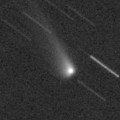
|
Fading now. It stays observable in good condition for a long time after this in the Southern Hemisphere. It is not observable until June in the Northern Hemisphere.
Date(TT) R.A. (2000) Decl. Delta r Elong. m1 Best Time(A, h)
May 5 0 50.52 -7 5.3 5.182 4.419 36 16.0 3:31 (271,-10)
May 12 0 53.05 -7 37.9 5.115 4.434 43 16.0 3:22 (274, -7)
|
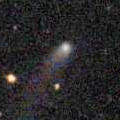
|
Now it is 16.1 mag (Apr. 15, Toshihiko Ikemura, Hirohisa Sato). It stays 16 mag for a long time from 2017 to 2018. It is observable in excellent condition in the Northern Hemisphere. It locates very low in the Southern Hemisphere.
Date(TT) R.A. (2000) Decl. Delta r Elong. m1 Best Time(A, h)
May 5 7 6.28 44 57.9 5.881 5.464 60 16.1 20:23 (122, 43)
May 12 7 7.72 45 7.3 5.989 5.475 55 16.2 20:31 (124, 37)
|
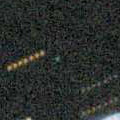
|
First return of a new periodic comet which brightened up to 13 mag in 2013. Now it is 17.2 mag (Apr. 20, Catalina Sky Survey). It will brighten very rapidly after this, up to 11 mag in summer. In the Southern Hemisphere, it stays observable in good condition all through this apparition. In the Northern Hemisphere, it is not observable at the high light from mid June to mid August.
Date(TT) R.A. (2000) Decl. Delta r Elong. m1 Best Time(A, h)
May 5 8 38.01 31 24.9 0.696 1.120 79 16.9 20:23 ( 95, 57)
May 12 8 42.11 29 1.4 0.663 1.051 74 16.1 20:31 ( 95, 50)
|

|
Now it is 16.0 mag (Apr. 6, Sandor Szabo). It will be fading slowly until summer.
Date(TT) R.A. (2000) Decl. Delta r Elong. m1 Best Time(A, h)
May 5 11 20.05 12 53.1 2.925 3.553 121 16.2 20:27 ( 0, 68)
May 12 11 20.26 12 34.5 3.013 3.556 114 16.3 20:31 ( 19, 66)
|
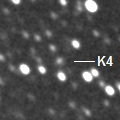
|
It was observed at 16 mag from summer to autumn in 2017. It will be observable at 16.5 mag in good condition also in 2018. It locates somewhat low in the Southern Hemisphere.
Date(TT) R.A. (2000) Decl. Delta r Elong. m1 Best Time(A, h)
May 5 23 49.11 10 5.9 3.538 2.894 43 16.4 3:31 (266, 12)
May 12 23 58.53 11 38.8 3.506 2.922 47 16.4 3:22 (266, 15)
|

|
It brightened up to 9.2 mag from November to December (Nov. 16, Juan Jose Gonzalez). Now it is fading rapidly. It has already faded down to 16.6 mag (Apr. 12, Toshihiko Ikemura, Hirohisa Sato). It stays observable in good condition until summer when it fades out.
Date(TT) R.A. (2000) Decl. Delta r Elong. m1 Best Time(A, h)
May 5 13 41.59 5 4.4 1.281 2.229 153 16.5 22:48 ( 0, 60)
May 12 13 37.00 4 34.3 1.362 2.277 147 16.9 22:16 ( 0, 59)
|
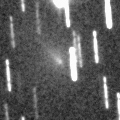
|
It brightened up to 15-16 mag in winter. Appearing in the morning sky. It stays observable at 16.5 mag for a while. It will be observable in good condition after this in the Southern Hemisphere. But it stays low in the Northern Hemisphere.
Date(TT) R.A. (2000) Decl. Delta r Elong. m1 Best Time(A, h)
May 5 22 52.42 -6 35.8 2.025 1.795 62 16.6 3:31 (288, 14)
May 12 22 47.72 -8 46.2 1.906 1.844 70 16.6 3:22 (294, 17)
|

|
Now it is 16.6 mag (Apr. 9, Toshihiko Ikemura, Hirohisa Sato). It will be fading slowly after this.
Date(TT) R.A. (2000) Decl. Delta r Elong. m1 Best Time(A, h)
May 5 10 17.64 8 59.1 9.275 9.647 108 16.7 20:23 ( 30, 61)
May 12 10 18.24 9 6.9 9.389 9.652 102 16.7 20:31 ( 45, 56)
|

|
Now it is 16.7 mag (Apr. 15, Toshihiko Ikemura, Hirohisa Sato). It will brighten up to 15 mag in January, 2019. It stays observable in excellent condition in the Northern Hemispehre. It is observable only until June in the Southern Hemisphere.
Date(TT) R.A. (2000) Decl. Delta r Elong. m1 Best Time(A, h)
May 5 10 53.57 33 32.7 3.644 4.032 105 16.9 20:23 ( 73, 85)
May 12 10 46.31 34 3.6 3.731 3.995 97 16.9 20:31 ( 90, 77)
|
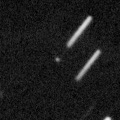
|
Now it is 16.3 mag (Apr. 15, Toshihiko Ikemura, Hirohisa Sato). It is observable at 16-17 mag from spring to summer.
Date(TT) R.A. (2000) Decl. Delta r Elong. m1 Best Time(A, h)
May 5 14 59.90 38 44.6 1.228 1.987 125 16.9 0:11 (180, 86)
May 12 14 55.10 36 44.4 1.212 1.974 125 16.9 23:34 (180, 89)
|

|
It has not been observed yet in this apparition. It will brighten rapidly, and it is expected to brighten up to 10 mag in autumn. It will be observable in excellent condition in the Northern Hemisphere. It stays low in the Southern Hemisphere.
Date(TT) R.A. (2000) Decl. Delta r Elong. m1 Best Time(A, h)
May 5 21 59.09 -11 38.0 2.470 2.438 76 17.3 3:31 (302, 20)
May 12 22 9.30 -10 22.4 2.335 2.384 80 17.0 3:22 (302, 23)
|
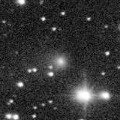
|
Now it is 16.5 mag (Apr. 20, Ken-ichi Kadota). It will be fading after this. In the Northern Hemisphere, it stays observable in the northern sky for a long time. It is not observable at all after this in the Southern Hemisphere.
Date(TT) R.A. (2000) Decl. Delta r Elong. m1 Best Time(A, h)
May 5 7 42.63 84 33.9 4.052 3.869 72 17.1 20:23 (174, 38)
May 12 8 33.13 82 24.2 4.119 3.905 70 17.2 20:31 (172, 40)
|

|
Now it is 16.4 mag (Apr. 19, Toshihiko Ikemura, Hirohisa Sato). It will be fading gradually after this, and it will be fainter than 18 mag in autumn. In the Northern Hemisphere, it stays observable in good condition for a long time. In the Southern Hemisphere, it will never be observable again.
Date(TT) R.A. (2000) Decl. Delta r Elong. m1 Best Time(A, h)
May 5 22 52.69 68 18.3 7.532 7.143 63 17.1 3:31 (207, 40)
May 12 23 1.41 69 4.6 7.554 7.166 63 17.2 3:22 (205, 41)
|

|
Now it is 16.6 mag (Apr. 21, Toshihiko Ikemura, Hirohisa Sato). It will be fainter than 18 mag in summer.
Date(TT) R.A. (2000) Decl. Delta r Elong. m1 Best Time(A, h)
May 5 14 45.11 -10 15.3 5.373 6.377 174 17.2 23:52 ( 0, 45)
May 12 14 41.91 -9 20.2 5.403 6.396 168 17.2 23:21 ( 0, 46)
|

|
Now it is 16.8 mag (Apr. 21, Alexander Baransky). It will be fading after this, and it will be fainter than 18 mag in July.
Date(TT) R.A. (2000) Decl. Delta r Elong. m1 Best Time(A, h)
May 5 11 32.63 25 43.3 5.201 5.728 116 17.3 20:40 ( 0, 81)
May 12 11 28.86 26 14.6 5.335 5.754 109 17.3 20:31 ( 30, 80)
|
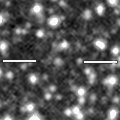
|
Now it is 17.9 mag (Apr. 21, Toshihiko Ikemura, Hirohisa Sato). It stays observable at 17 mag in good condition from spring to autumn.
Date(TT) R.A. (2000) Decl. Delta r Elong. m1 Best Time(A, h)
May 5 20 55.82 -0 38.5 5.942 5.993 88 17.3 3:31 (306, 39)
May 12 20 58.03 -0 10.4 5.837 5.991 93 17.3 3:22 (310, 42)
|
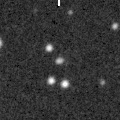
|
Now it is 16.3 mag (Apr. 20, Toshihiko Ikemura, Hirohisa Sato). It is observable at 17 mag in good condition in spring.
Date(TT) R.A. (2000) Decl. Delta r Elong. m1 Best Time(A, h)
May 5 12 44.21 -9 53.2 1.611 2.532 149 17.4 21:51 ( 0, 45)
May 12 12 43.10 -9 24.8 1.656 2.532 142 17.5 21:23 ( 0, 46)
|
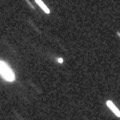
|
Now it is 16.9 mag (Apr. 12, Toshihiko Ikemura, Hirohisa Sato). It will be fading gradually after this.
Date(TT) R.A. (2000) Decl. Delta r Elong. m1 Best Time(A, h)
May 5 10 40.32 36 54.2 8.043 8.302 101 17.5 20:23 (106, 83)
May 12 10 38.24 36 15.9 8.168 8.322 95 17.6 20:31 (100, 75)
|

|
Now it is 19.3 mag (Apr. 20, Toshihiko Ikemura, Hirohisa Sato). It was predicted to be observable at 17.5 mag in good condition from spring to summer. But recently, it is fainter than predicted.
Date(TT) R.A. (2000) Decl. Delta r Elong. m1 Best Time(A, h)
May 5 16 29.37 -7 59.3 2.951 3.881 153 17.6 1:40 ( 0, 47)
May 12 16 25.62 -7 52.7 2.917 3.881 159 17.6 1:09 ( 0, 47)
|

|
Now it is 17.5 mag (Apr. 21, Catalina Sky Survey). It stays observable at 17-18 mag in good condition for a while.
Date(TT) R.A. (2000) Decl. Delta r Elong. m1 Best Time(A, h)
May 5 14 54.03 -3 46.6 1.821 2.814 167 17.6 0:05 ( 0, 51)
May 12 14 48.30 -3 33.2 1.865 2.850 164 17.8 23:27 ( 0, 51)
|
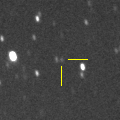
|
Now it is 17.8 mag (Apr. 6, J. Drummond). It stays 18 mag from 2018 to 2020. It is observable in good condition in the Southern Hemisphere. It locates extremely low in the Northern Hemisphere.
Date(TT) R.A. (2000) Decl. Delta r Elong. m1 Best Time(A, h)
May 5 12 23.58 -37 5.3 3.671 4.509 142 17.9 21:30 ( 0, 18)
May 12 12 20.38 -36 35.6 3.707 4.505 137 17.9 21:00 ( 0, 18)
|
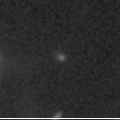
|
Now it is 16.6 mag (Apr. 19, Toshihiko Ikemura, Hirohisa Sato). It is observable at 18 mag in good condition in spring.
Date(TT) R.A. (2000) Decl. Delta r Elong. m1 Best Time(A, h)
May 5 12 18.45 0 37.6 1.305 2.174 139 17.9 21:26 ( 0, 56)
May 12 12 18.57 1 12.7 1.340 2.157 132 17.9 20:58 ( 0, 56)
|
|
![]()
 C/2017 T3 ( ATLAS )
C/2017 T3 ( ATLAS ) C/2015 O1 ( PanSTARRS )
C/2015 O1 ( PanSTARRS ) 29P/Schwassmann-Wachmann 1
29P/Schwassmann-Wachmann 1 48P/Johnson
48P/Johnson 37P/Forbes
37P/Forbes 21P/Giacobini-Zinner
21P/Giacobini-Zinner C/2015 V2 ( Johnson )
C/2015 V2 ( Johnson ) C/2017 M4 ( ATLAS )
C/2017 M4 ( ATLAS ) C/2017 B3 ( LINEAR )
C/2017 B3 ( LINEAR ) C/2017 S3 ( PanSTARRS )
C/2017 S3 ( PanSTARRS ) 65P/Gunn
65P/Gunn C/2015 VL62 ( Lemmon-Yeung-PanSTARRS )
C/2015 VL62 ( Lemmon-Yeung-PanSTARRS ) (3552) Don Quixote
(3552) Don Quixote C/2015 V1 ( PanSTARRS )
C/2015 V1 ( PanSTARRS ) C/2016 A1 ( PanSTARRS )
C/2016 A1 ( PanSTARRS ) 364P/2018 A2 ( PanSTARRS )
364P/2018 A2 ( PanSTARRS ) 74P/Smirnova-Chernykh
74P/Smirnova-Chernykh C/2017 K4 ( ATLAS )
C/2017 K4 ( ATLAS ) 62P/Tsuchinshan 1
62P/Tsuchinshan 1 C/2017 S6 ( Catalina )
C/2017 S6 ( Catalina ) C/2014 B1 ( Schwartz )
C/2014 B1 ( Schwartz ) C/2018 A3 ( ATLAS )
C/2018 A3 ( ATLAS ) C/2018 C2 ( Lemmon )
C/2018 C2 ( Lemmon ) 64P/Swift-Gehrels
64P/Swift-Gehrels C/2016 N4 ( MASTER )
C/2016 N4 ( MASTER ) C/2014 OE4 ( PanSTARRS )
C/2014 OE4 ( PanSTARRS ) C/2017 E3 ( PanSTARRS )
C/2017 E3 ( PanSTARRS ) C/2017 D3 ( ATLAS )
C/2017 D3 ( ATLAS ) C/2017 M5 ( TOTAS )
C/2017 M5 ( TOTAS ) 143P/Kowal-Mrkos
143P/Kowal-Mrkos C/2014 R3 ( PanSTARRS )
C/2014 R3 ( PanSTARRS ) 187P/LINEAR
187P/LINEAR 30P/Reinmuth 1
30P/Reinmuth 1 186P/Garradd
186P/Garradd 105P/Singer Brewster
105P/Singer Brewster![]()



































